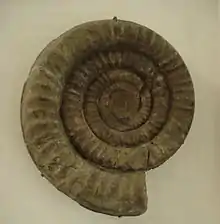Coroniceras
Coroniceras is a genus in the Arietitidae, a family in the ammonitid superfamily Psiloceratoidea, from the lower Sinermurian stage in the Lower Jurassic. It is a sub zone ammonite of the Arnioceras semicostatum Zone.
| Coroniceras | |
|---|---|
 | |
| Coroniceras rotiforme | |
| Scientific classification | |
| Kingdom: | |
| Phylum: | |
| Class: | |
| Subclass: | |
| Order: | |
| Superfamily: | |
| Family: | |
| Subfamily: | Arietitinae |
| Genus: | Coroniceras Arkell (1947) |
| Species [2] | |
| |
| Synonyms | |
| |
Coroniceras has a thin discoidal form with a circular whorl section, arched venter, single tall keel, and few but strong ribs. Coroniceras is included in the subfamily Arietitinae.
Fossils of Coroniceras bucklandi are commonly found at Lyme Regis, Dorset Coast, England in the higher limestones of the Blue Lias.[3]
References
- Sepkoski, Jack (2002). "A compendium of fossil marine animal genera (Cephalopoda entry)". Bulletins of American Paleontology. 363: 1–560. Archived from the original on 2008-05-07. Retrieved 2017-10-18.
- "Paleobiology Database - Coroniceras". Retrieved 2014-05-28.
- Davies, G. M. 1964. The Dorset Coast London: Adam and Charles Black.
This article is issued from Wikipedia. The text is licensed under Creative Commons - Attribution - Sharealike. Additional terms may apply for the media files.